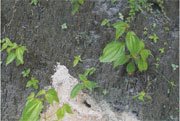Terra Preta: Black is the New Green
 I first learned learned of terra preta while reading the fantastic book 1491 (see previous post). Terra preta or Amazonian Dark Earth was created by ancient Amazonians by burning old crop waste until it was charred rather than burning it all the way. The resulting soil retained more water and nutrients and greatly increased crop yields. Turns out it is also a great way to sequester carbon.
I first learned learned of terra preta while reading the fantastic book 1491 (see previous post). Terra preta or Amazonian Dark Earth was created by ancient Amazonians by burning old crop waste until it was charred rather than burning it all the way. The resulting soil retained more water and nutrients and greatly increased crop yields. Turns out it is also a great way to sequester carbon.
Bruno Glaser, of the University of Bayreuth, Germany, a sometime collaborator of Sombroek's, estimates that productivity of crops in terra preta is twice that of crops grown in nearby soilsWow! Not only do you get a soil that could increase crop productivity by 200-300%, you also have a way to sequester carbon on a scale that could offset all fossil fuel emissions. Instead of being carbon neutral, they are now talking about going carbon negative.
According to Glaser's research, a hectare of metre-deep terra preta can contain 250 tonnes of carbon, as opposed to 100 tonnes in unimproved soils from similar parent material.
That difference of 150 tonnes is greater than the amount of carbon in a hectare's worth of plants. That means turning unimproved soil into terra preta can store away more carbon than growing a tropical forest from scratch on the same piece of land
He estimates that by the end of this century terra preta schemes, in combination with biofuel programmes, could store up to 9.5 billion tonnes of carbon a year — more than is emitted by all today's fossil-fuel use.
Sounds like a sure winner, what is the downside?
One problem is that the purported benefits of char do not slot easily into the framework of the Kyoto Protocol, an international agreement to reduce carbon emissions.Cellulosic ethanol might also compete with it for crop wastes to turn auto fuel rather than char.
Then there are your risk-averse farmers.
"Can you do this in a no-till way?" is one tricky query.
Eprida is a company that is creating terra preta along with hydrogen rich bio-fuels.
All in all it looks like a very promising technology and one to keep your eyes on.
via World Changing and Nature





2 comments:
There is an ecology going on in these soils that is not completely understood, and if replicated and applied at scale would have multiple benefits for farmers and environmentalist.
Terra Preta creates a terrestrial carbon reef at a microscopic level. These nanoscale structures provide safe haven to the microbes and fungus that facilitate fertile soil creation, while sequestering carbon for many hundred if not thousands of years. The combination of these two forms of sequestration would also increase the growth rate and natural sequestration effort of growing plants.
Also, Terra Preta was on the Agenda at this years world Soil Science Conference !
http://crops.confex.com/crops/wc2006/te ... P16274.HTM
I've sent this thread to the researchers at M-Roots, who make Mycorisal fungus inoculations for acceleration of the reestablishment of the symbiotic fungal / root relationship. Here's the M-Roots site: http://www.rootsinc.com/
Here is a great article that high lights this pyrolysis process , ( http://www.eprida.com/hydro/ ) which could use existing infrastructure to provide Charcoal sustainable Agriculture , Syn-Fuels, and a variation of this process would also work as well for H2 , Charcoal-Fertilizer, while sequestering CO2 from Coal fired plants to build soils at large scales , be sure to read the "See an initial analysis NEW" link of this technology to clean up Coal fired power plants.
Soil erosion, energy scarcity, excess greenhouse gas all answered through regenerative carbon management http://www.newfarm.org/columns/research ... coal.shtml
If pre Columbian Indians could produce these soils up to 6 feet deep over 20% of the Amazon basin it seems that our energy and agricultural industries could also product them at scale.
Harnessing the work of this vast number of microbes and fungi changes the whole equation of EROEI for food and Bio fuels. I see this as the only sustainable agricultural strategy if we no longer have cheap fossil fuels for fertilizer.
I would like to investigate if use of an M-Roots type fungus inoculant and local compost would speed this super community of wee beasties in populating into their proper Soil horizon Carbon Condos.
I feel Terra Preta soil technology is the greatest of Ironies since Tobacco.
That is: an invention of pre-Columbian American culture, destroyed by western disease, may well be the savior of industrial western society. As inversely Tobacco, over time has gotten back at same society by killing more of us than the entire pre-Columbian population.
Erich J. Knight
Thanks for the info Erich.
That is an interesting point you make about Terra Preta being like a carbon reef at a microscopic level. I like that analogy.
Post a Comment
Note: Only a member of this blog may post a comment.